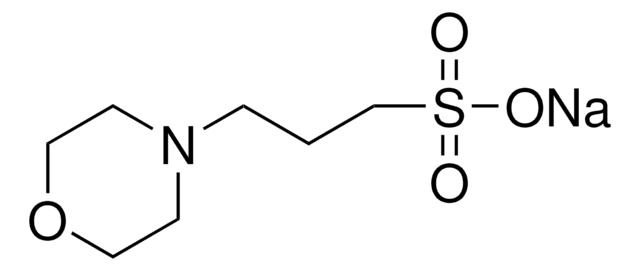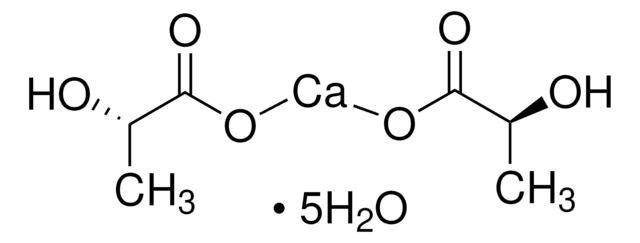RES6007H-A7
HEPES sodium salt
의약품 제조
동의어(들):
4-(2-Hydroxyethyl)piperazine-1-ethanesulfonic acid sodium salt, N-(2-Hydroxyethyl)piperazine-N′-(2-ethanesulfonic acid) sodium salt
About This Item
추천 제품
생물학적 소스
synthetic
Quality Level
형태
powder
기술
cell culture | mammalian: suitable
불순물
Endotoxin, microbial, and trace metals; tested
유용한 pH 범위
6.8-8.2
pKa(25 °C)
7.5
적합성
suitable for manufacturing use
외래 활성
Cytotoxicity, DNase, NICKase, RNase, and Protease; tested
SMILES string
[Na+].OCCN1CCN(CC1)CCS([O-])(=O)=O
InChI
1S/C8H18N2O4S.Na/c11-7-5-9-1-3-10(4-2-9)6-8-15(12,13)14;/h11H,1-8H2,(H,12,13,14);/q;+1/p-1
InChI key
RDZTWEVXRGYCFV-UHFFFAOYSA-M
유사한 제품을 찾으십니까? 방문 제품 비교 안내
일반 설명
M-Clarity Program
Buffer quality is vital for the success of biopharmaceutical processes, because buffers are indispensable in nearly every production step.
Our broad portfolio of buffer materials manufactured under appropriate controls is tailored to your needs. Ranging from non-GMP grades for low-risk application, to IPEC-PQG GMP for higher-risk applications, we have products covering all your manufacturing needs.
애플리케이션
HEPES Sodium is used in cell culture media, biopharmaceutical buffer formulations (both upstream and downstream) and diagnostic reagent formulations.
포장
RES6007H-A701X: 100g container
RES6007H-A702X: 1kg container
RES6007H-A704X: 10kg container
RES6007H-A705X: 25kg container
법적 정보
교체됨
Storage Class Code
11 - Combustible Solids
WGK
WGK 3
Flash Point (°F)
Not applicable
Flash Point (°C)
Not applicable
시험 성적서(COA)
제품의 로트/배치 번호를 입력하여 시험 성적서(COA)을 검색하십시오. 로트 및 배치 번호는 제품 라벨에 있는 ‘로트’ 또는 ‘배치’라는 용어 뒤에서 찾을 수 있습니다.
이미 열람한 고객
자사의 과학자팀은 생명 과학, 재료 과학, 화학 합성, 크로마토그래피, 분석 및 기타 많은 영역을 포함한 모든 과학 분야에 경험이 있습니다..
고객지원팀으로 연락바랍니다.



